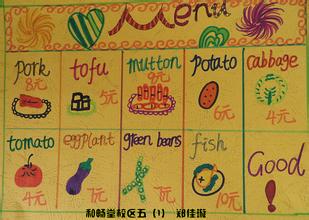
Xiaohua:Hello and welcome to Round Table as the Word of the Week. This week we are talking about one of my favorite topics - cooking.
John:Yeah actually when I was researching this topic, it really just made me kind of want to get back into cooking again. Recently my mother-in-law has been doing a lot of cooking, but I haven't. But we're just going to give you a quick list of some commonly-use words you might see in like an English recipe book, or when someone is talking about cooking. The first one we are looking at is blanching.
Xiaohua:Blanching其实就是我们常说的焯,焯一下。
John:There you go! Interesting! In English, obviously it's same in Chinese, all you do is put vegetable or fruit, but usually vegetable, into boiling water, and after a very very short period of time, take it out and put it into iced water or cold running water to immediately halt the cooking process.
Xiaohua:焯的诀窍就是在焯完之后要立刻放到凉水里面,以避免食材被煮得过熟。
John:And then the next is braising. It's a combination cooking method using both moist and dry heat. So usually the food is first searedwe will talk about that in a minute:in a high temperature, and then finish in a covered pot with a variable amount of liquid.
Xiaohua:Braise很多人都以为就是炖的意思,但其实braise是先用高温煎炸过,然后再炖。
John:Yeah and there is simmering. Simmering is used a lot in western cooking. Basically you bring whatever liquid you have in your pot up to boiling and you turn the heat down to just keep it just below boiling. So it's not on the lowest setting. But it's just keeping the liquid at a temperature that it's not actually boiling.
Xiaohua:Simmering就是小火煮然后刚好火要小到让它将开锅又没有开锅的时候。
John:And now let's look at sautéing, which is a type of frying. And it's actually from the French "sauté", which means "jumped or bounced", so basically in reference to tossing while cooking. So use a small amount of oil or fat in a shallow pan over pretty high heat, and the ingredients that you sauté are gonna be thinly cut or chopped into small pieces such like an onion or pieces of a mashed garlic or something like that. And over high heat you just sauté really really quickly then you add other stuff and finish off the recipe.
Xiaohua:Sauté是西餐里用到的一种炒菜的方法,需要"颠勺"这种技巧。It's actually pretty close to what the Chinese call "stir-fry", but it's different.
John:It's different because stir-fry is complete method. You can make an entire meal using stir-fry. Sauté is usually used in the beginning of a recipe. For example, if I am cooking ground meat or something like that, I'll probably start by sautéing onions and garlic together, then putting in the ground meat. And I wouldn't be sautéing the ground meat.
Xiaohua:I see. 所以在西餐里的Sauté可能只是做菜的一小部分。
John:And now we gonna keep moving on. Next up is barbecuing. I think many people would know that. Basically it's just cooking meat, or pretty much anything actually, using hot smoke of a fire, smoking wood or hot coals of charcoal.
Xiaohua:Barbecue 不需要解释啦。
John:Exactly. And then there is grilling. So here is the thing actually - grill usually refers to barbecuing. You grill something, you barbecue something on a grill, you are grilling. Grill can also be used inside. If you have a griddle, for example, or even you have just a regular pan, but you are grilling a hamburger inside.
Xiaohua:Grill既可以是户外烧烤,也可以是用烤架,烤炉,甚至是平底锅来烤。
John:Then there is a rotisserie, where meat is skewered, a whole, a big metal stick, all the way of the other, and then it is stuck on the machine where just keeps rotating so that no one piece of meat usually is over the fire or heat source for too long.
Xiaohua:Yummy. Rotisserie指的是用烤叉穿过要烤的,一般是鸡,或者是其他的肉类,然后在电烤炉里面一边转一边烤。
John:Yeah in western cooking, it's usually chicken. And then there is searing. Searing is actually used a lot more than you might think and we talked about it before. But it's basically, what you do is the surface of the food is cooked at very very high temperature so that a crust kind of forms on the outside. And the whole purpose isn't necessarily to actually fully cook the meat, but just to get a nice crust on the outside. Sometimes it's also be browning or blackening so the temperature of the pan that you are using and the oil if you are using oil: is gonna be very very high and you are only cooking it for a little bit more than likely after that you're going to be putting it into the oven to finish cooking all together.
Xiaohua:Searing有一点点像炸,但是不是deep-fry,而是刚好要炸到表面上微微发焦,然后再继续之后的制作过程。
John:Exactly. And then the last but not least is marination, one of my favorite processes when I was cooking meat. And basically you're just soaking foods in a seasoned liquid before cooking. And the best type as usually as gonna use is acidic marinade with vinegar, lemon juice, or wine, or enzymatic, which I think is quite interesting, pineapple, papaya or kiwifruit. You let it sit for maybe even a couple of days before you actually cook it up.
Xiaohua:Marinade是一种腌制的过程,经常要在做肉的时候用到。有的时候marinade可以持续一天以上。
John:Yeah I mean sometimes marinade can be very short. But the whole purpose is just to get the flavors from the liquid actually into the meat. It's actually different from a sauce. Sauce is only on the outside, but if you marinate, especially for longer time.












